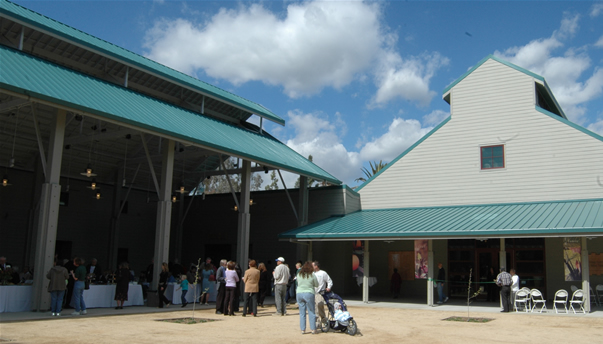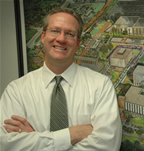Cal State Fullerton Goes Green With Energy Efficiency, Building Design
Efforts are being made to save energy and use renewable resources
February 5, 2007
By Pamela McLaren
To the visitor and most of the campus community, Cal State Fullerton is filled with white buildings. Few realize that some of those buildings are “green.”
That’s because of efforts to build and maintain buildings that save energy and use renewable resources.
Buildings like the Fullerton Arboretum Visitor Center and Orange County Agricultural and Nikkei Heritage Museum, as well as Steven G. Mihaylo Hall — still under construction — have a number of items that make them “green” buildings.
The Arboretum structure features natural ventilation and light; low-flow faucets and low-volume toilets; lighting with multilevel switching and motion sensors; and recycled building materials for exterior siding, insulation and flooring.
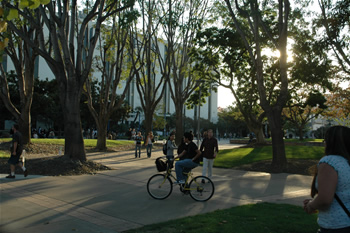 |
In 2005, the center’s design garnered a Best Practices Award for Overall Sustainable Design during the 4th annual UC/CSU Sustainability Conference. In addition, two awards further enhance the center’s green qualities: a $45,000 grant from the Metropolitan Water District of Southern California to fund new Southern California heritage landscapes and a donation of 40 cubic yards of pervious concrete to park on by the Southern California Ready Mixed Concrete Association.
Similarly, the five-story, 195,000-square-foot Mihaylo Hall will feature a number of elements designed for energy efficiency, including a reflectant or cool roof system, sun shading devices, high-performance glazing, energy-efficient lighting and an automated building control system. Landscaping for the structure will include native, drought-tolerant plants.
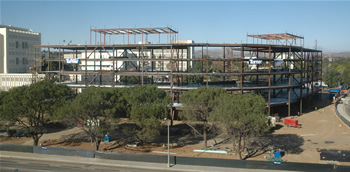 |
This year, the campus earned a UC/CSU Sustainability Conference Best Practice Award honorable mention for the heating, ventilation and air conditioning design of the Titan Student Union’s central plant addition. Upgrades to the university’s utility infrastructure, including the central plant, were begun last summer.
“We do real well in terms of energy consumption,” said Jay Bond, associate vice president, facilities management, noting that Cal State Fullerton is purchasing 16 percent alternate or “green” power, which is defined as electricity that is partially or entirely generated from environmentally friendly resources, such as solar, wind, geothermal or other means. The campus also has upgraded lighting, as well as its heating and cooling systems, to be more energy efficient. “We have one of the most energy-efficient campuses in the state because we use less BTUs per square foot, and per student, than other CSU campuses,” said Bond.
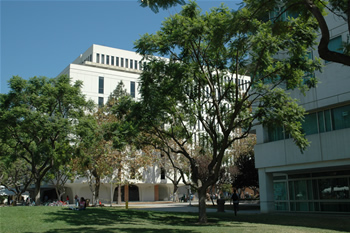 |
The effort really kicked off in the 1990s, said Willem van der Pol, director of physical plant. The first upgrade of the central plant began in 1990 and earned the campus a $1 million award from Edison for the project’s innovative thermal energy storage system.
The campus also is looking into other programs and smaller projects to help in the effort, such as recently replacing the refrigeration units in the College of Natural Sciences and Mathematics with more energy-efficient models. In 2003, the campus acquired 11 new electric vehicles thanks to the Ford Think Neighbor Placement Program. The vehicles are used by Parking and Transportation, Public Safety and instructional technology staff to get around the 236-acre campus. And ongoing efforts are continuing the trend toward more electric and alternative fuel vehicles.
In an effort to protect the environment, in general, and provide a healthier indoor environment, van der Pol noted that Physical Plant has implemented custodial cleaning that minimizes particles and chemicals in the air and increases the use of recycled paper products, as well as biodegradable cleaning chemicals. “We will continue to focus on preventive measures as much as possible so fewer and milder chemicals can be used,” he added.
The campus recycles 60 percent of its waste, including concrete torn up from its construction projects.
“We still have room for even greater improvement. But, we are proud of what we have done, beginning well before ‘green’ was fashionable,” said Bond. “We are taking a leadership role in making sustainable initiatives happen, and are well on our way to ‘greening’ the Cal State Fullerton campus. Generations to come will benefit from our efforts today.”

